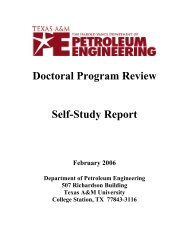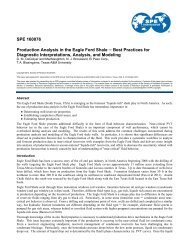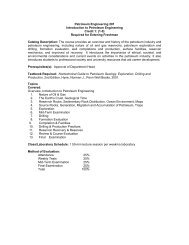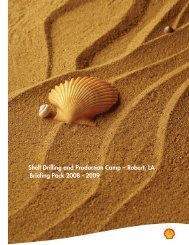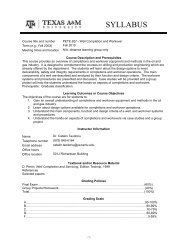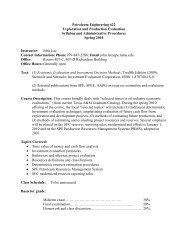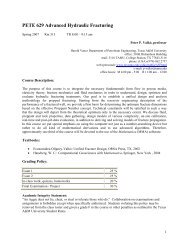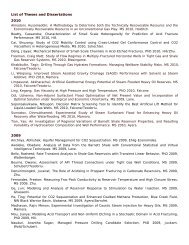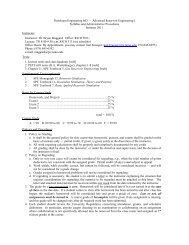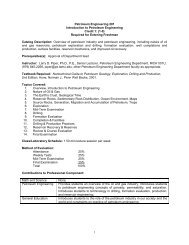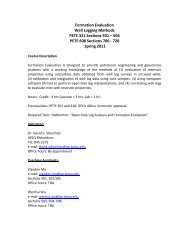Crisman Annual Report 2009 - Harold Vance Department of ...
Crisman Annual Report 2009 - Harold Vance Department of ...
Crisman Annual Report 2009 - Harold Vance Department of ...
You also want an ePaper? Increase the reach of your titles
YUMPU automatically turns print PDFs into web optimized ePapers that Google loves.
An Advisory System for Selecting Drilling Technologies and Methods in Tight Gas<br />
Reservoirs<br />
Objectives<br />
The main objective <strong>of</strong> this research project is to<br />
develop a computer program dedicated to applying<br />
the drilling technologies and methods selection for<br />
drilling tight gas sandstone formations that have<br />
been documented as best practices in the petroleum<br />
literature. We have created an advisory module<br />
for tight gas that is part <strong>of</strong> a general Drilling &<br />
Completion Advisor for unconventional formations.<br />
This Drilling & Completion Advisory Module, along<br />
two other programs called BASIN (basin analogy)<br />
and PRISE (resource evaluation) is part <strong>of</strong> the<br />
UGR (unconventional gas resources) Advisor under<br />
development at Texas A&M by a team <strong>of</strong> graduate<br />
students and pr<strong>of</strong>essors.<br />
Approach<br />
To complete the Drilling Advisory Module for tight<br />
gas reservoirs, we have identified and reviewed<br />
relevant data in worldwide literature on tight gas<br />
reservoirs with a strong emphasis on the latest<br />
drilling technologies, such as: casing drilling,<br />
underbalanced drilling, managed pressure drilling,<br />
horizontal drilling, directional S-shaped drilling (well<br />
clusters) and coiled tubing drilling. We have analyzed<br />
under which critical parameters one technology<br />
has been preferred or is currently being applied in<br />
comparison with other drilling techniques. Further,<br />
we have extracted key criteria and have developed<br />
decision charts, which mimic the thinking process <strong>of</strong><br />
an expert. We have written Visual Basic programs<br />
using Micros<strong>of</strong>t Visual Studio implementing all the<br />
decisions charts created during this research. Finally,<br />
we will test and validate the Drilling Advisory Module<br />
with U.S. tight gas real cases.<br />
Accomplishments<br />
Our results have led to the following accomplishments:<br />
» A drilling advisory system has been designed and<br />
programmed for a Windows O.S. environment in<br />
order to capture the industry best drilling practices<br />
from tight gas reservoirs.<br />
» The advisory system has been divided into<br />
several sub-modules to guide the user through<br />
the multiple steps to make decision selecting<br />
drilling technologies and methods to drill tight gas<br />
reservoirs. Each <strong>of</strong> the sub-modules deals with<br />
a specific topic (well data, drilling parameters,<br />
drilling time, drilling cost, ranking). Each dataset<br />
can be loaded or saved in a text file for analysis<br />
or post-processing using other s<strong>of</strong>tware (Micros<strong>of</strong>t<br />
Excel).<br />
» The advisory system is designed with a user-friendly<br />
interface, to help select efficient and successful<br />
drilling technologies and drilling methods.<br />
» The drilling advisory system outputs more than<br />
one feasible solution for a given well or field.<br />
» The logic behind the advisory system, mainly based<br />
on decision charts developed by collecting relevant<br />
data from the petroleum engineering literature<br />
and discussions with industry drilling experts, is a<br />
good approach to mimic expert decision-making.<br />
» This project has illustrated several examples that<br />
happen to match the current industry drilling best<br />
practices or anticipate upcoming drilling practices<br />
in the studied area. These simulations showed that<br />
the drilling advisory system could deliver similar<br />
recommendations in comparison with a team <strong>of</strong><br />
experienced drilling experts.<br />
» Drilling time, drilling cost estimation and ranking<br />
technologies, and methods sub-modules provide<br />
the user with an extended decision making tool<br />
when several solutions are feasible.<br />
» The drilling advisory system has been designed<br />
and programmed for easy integration within the<br />
Unconventional Gas Resources Advisor. It can be<br />
further upgraded with other drilling sub-modules<br />
or new drilling technologies when they are mature<br />
on the market.<br />
Project Information<br />
1.1.12 Developing an Expert System for Well Completions<br />
in Tight Gas Reservoirs Worldwide<br />
Related Publications<br />
Pilisi, N.: <strong>2009</strong>. An Advisory System for Selecting Drilling<br />
Technologies and Methods in Tight Gas Reservoirs. MS<br />
thesis, Texas A&M U., College Station, Texas.<br />
Contacts<br />
Stephen A. Holditch<br />
979.845.2255<br />
holditch@tamu.edu<br />
Catalin Teodoriu<br />
catalin.teodoriu@pe.tamu.edu<br />
Nicolas Pilisi<br />
CRISMAN INSTITUTE<br />
14<br />
<strong>Crisman</strong> <strong>Annual</strong> <strong>Report</strong> <strong>2009</strong>



